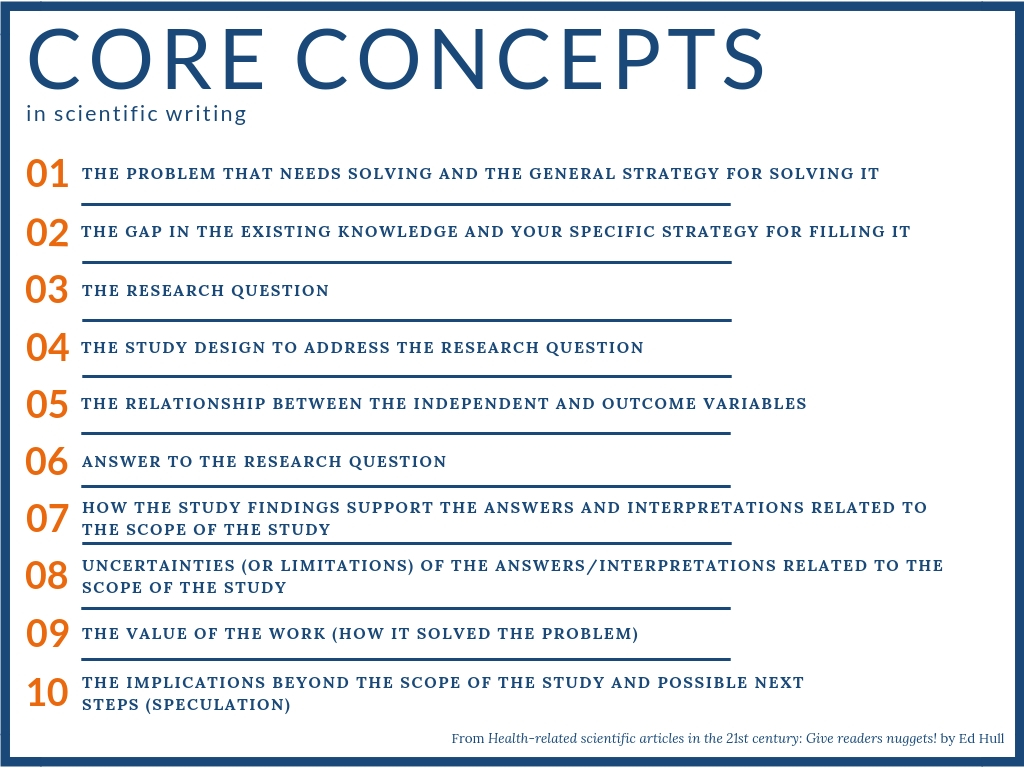 Anyone who edits biomedical research papers for a living will know that many scientists struggle to write clear, well-structured research papers that are easy to read. Many still insist on using an archaic writing style, filled with complicated prose that (they think) impresses their peers, instead of doing what they should do, which is focusing on their readers’ needs. They firmly believe that this is how scientists ‘should’ write, and that if they don’t write in this way, their papers will not sound important enough and will not be accepted for publication. This is what we, as editors of scientific papers, are up against.
Anyone who edits biomedical research papers for a living will know that many scientists struggle to write clear, well-structured research papers that are easy to read. Many still insist on using an archaic writing style, filled with complicated prose that (they think) impresses their peers, instead of doing what they should do, which is focusing on their readers’ needs. They firmly believe that this is how scientists ‘should’ write, and that if they don’t write in this way, their papers will not sound important enough and will not be accepted for publication. This is what we, as editors of scientific papers, are up against.
We must therefore find a solution to this problem. The truth is that this archaic style doesn’t only make scientific articles difficult to read – it actually gets in the way of reporting credible science.
Enter long-time SENSE member Ed Hull, with his latest book: Health-related Scientific Articles in the 21st Century: Give readers nuggets! In his book, Ed describes an easy-to-follow writing strategy that ensures precise, accurate and honest reporting of research findings. Ed shows scientists how to communicate credible research by focusing on specific take-home messages, or ‘core concepts’.
‘A good scientific article’, Ed says, ‘should teach the reader something’. And people learn better by grasping the core concepts before trying to understand the underlying details. Ed likens these core concepts to nuggets: ‘A nugget of gold is easy to pick up and has immediate value.’ In the context of scientific writing, an author can give their reader valuable nuggets of information to communicate what they want to say more clearly.
Cut to the core
In his book, Ed presents a template of 10 core concepts for research scientists to use when constructing their articles. This template structures the manuscript by bringing the take-home messages together. Core concepts 1–5 form the structure of the Introduction and core concepts 6–10 build the Discussion (see below).

Ed guides his reader through these core concepts, explaining each one in detail and using examples of fictitious studies to show the reader exactly how to write each core concept. There is continuous emphasis on leaving out details and being clear, which is a good thing as many scientists tend to get bogged down in unnecessary details. With this template of core concepts, Ed’s readers have the basis for writing a well-structured Introduction and Discussion. There is also a chapter on how to write the Methods and Results sections of a research paper, and how to structure these sections logically using subheadings, as well as another chapter on how to give the title and abstract maximum impact.
Specific focus
As he guides the reader through his writing strategy, Ed gives plenty of useful tips. One of the most useful (in my opinion) is the instruction to specify the scope of your study. This may seem rather obvious, but many scientists are afraid to – and don’t – do this. They feel that by narrowing the scope of their study, their findings will seem less important and less interesting. This fear is understandable, considering how much pressure scientists are under to publish, publish, publish in journals with the highest possible impact.
But Ed sensibly points out that focusing on a specific scope actually increases the credibility of a study in the mind of the reader because the author does not fall into the trap of mistakenly implying their study is bigger than it actually is. By maintaining this all-important focus, the methods will adequately address the scope of the study and the results will be credibly generalizable to the specific study population. A knock-on effect of this is that scientists will be less reluctant to acknowledge the limitations of their studies, thereby promoting accountability and research integrity.
This is one valuable golden nugget that I will be passing on to my own clients.
Getting the structure right
Ed’s strategy for writing research manuscripts helps solve another common problem among scientists: considering the overall structure of the manuscript and putting the right information in the relevant section. It may seem obvious what should go into the Introduction, Methods, Results and Discussion sections, but for some reason, authors of research articles often wind up interpreting their findings in the Results section, repeating their results and background information in the Discussion, or not answering their specific research question at all.
Ed helps researchers forget about details and focus on their take-home messages when writing their papers. Explaining each of these messages clearly and explicitly means the reader can focus on the scientific content of the research paper instead of struggling to find the point.
How to be reader friendly
A reader will have an easier time understanding an article that is well structured not only at the document level, but also at the paragraph and sentence levels. To help his reader break the habit of writing in a pompous, archaic style that is difficult to understand, Ed provides 10 helpful techniques for structuring reader-friendly sentences. He makes a concrete case for using the active voice and warns against ambiguous verbs and empty phrases that can leave the reader guessing. He also explains how to structure these reader-friendly sentences into logical paragraphs that tie the story together in a way that makes the reader want to keep reading (Ed provides a list of useful connecting words and phrases in the Appendix, which will be particularly useful for ESL authors). Ed illustrates each of his tips and techniques with helpful examples.
Much needed help
Ed has drawn on his experience as a researcher and teacher of scientific writing to develop an effective strategy for writing clear, well-written research articles – something which is sorely needed in academia. His ideas are well presented and easy to follow and should benefit native English-speaking and ESL authors alike. The book accompanies a successful writing course for PhD students that is held eight times a year at AMC in Amsterdam.
Ed’s book is also helpful to anyone who edits biomedical research papers. I for one am looking forward to passing on his wisdom to my own clients. Want to find out more? You can get your copy of Ed’s book here.